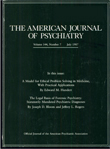Manic Reaction After Induction of Ovulation With Gonadotropins
Ms. A, a 34-year-old married woman with no significant psychiatric history or family psychiatric history, was undergoing ovulation induction for secondary infertility. Her obstetric history included two first-trimester spontaneous abortions. After complete evaluation by a gynecologist, she had been diagnosed with secondary infertility and had received clomiphene, with no response. Several months later she embarked on ovulation induction that used urofollitropin and human chorionic gonadotropin. Urofollitropin, a follicle-stimulating hormone (FSH) preparation, was given intramuscularly daily from day 8 to day 12 of the patient's regular 4/24-day menstrual cycle. Estradiol levels were monitored and on day 12 attained the concentration of 2,171 pmol/liter (normal range=110–2,202 pmol/liter), indicating ripe follicles. On days 13 and 14 of her cycle, chorionic gonadotropin, a luteinizing hormone (LH) preparation, was given to induce ovulation.
Approximately midway through the course of ovulation induction, Ms. A experienced a rapid and dramatic heightening in mood. She described feeling “high and energized,” while friends observed that she was inappropriately happy, very talkative, and somewhat bizarre. Ms. A also described symptoms of reduced sleep, racing thoughts, and overactivity. In addition, she became hypersexual and preoccupied with sexual thoughts. She eventually had an extramarital affair with a man she met 1 week after her last hormone injection, and this led to the breakup of her 5-year marriage. After 2 months, the manic symptoms began to subside, and she recovered insight into her uncharacteristic behavior. She subsequently became clinically depressed and was hospitalized with suicidal ideation. She was treated with sertraline, 50 mg/day, with good response.
References
Information & Authors
Information
Published In
History
Authors
Metrics & Citations
Metrics
Citations
Export Citations
If you have the appropriate software installed, you can download article citation data to the citation manager of your choice. Simply select your manager software from the list below and click Download.
For more information or tips please see 'Downloading to a citation manager' in the Help menu.
View Options
View options
PDF/EPUB
View PDF/EPUBGet Access
Login options
Already a subscriber? Access your subscription through your login credentials or your institution for full access to this article.
Personal login Institutional Login Open Athens loginNot a subscriber?
PsychiatryOnline subscription options offer access to the DSM-5-TR® library, books, journals, CME, and patient resources. This all-in-one virtual library provides psychiatrists and mental health professionals with key resources for diagnosis, treatment, research, and professional development.
Need more help? PsychiatryOnline Customer Service may be reached by emailing [email protected] or by calling 800-368-5777 (in the U.S.) or 703-907-7322 (outside the U.S.).

